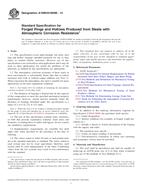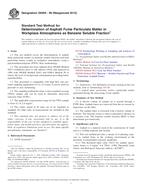1.1 This guide provides specific requirements to statistically evaluate measurand alarm thresholds, which are called alarm limits, as they are applied to data collected from in-service oil analysis. These alarm limits are typically used for condition monitoring to produce severity indications relating to states of machinery wear, oil quality, and system contamination. Alarm limits distinguish or separate various levels of alarm. Four levels are common and will be used in this guide, though three levels or five levels can also be used.
1.2 A basic statistical process control technique described herein is recommended to evaluate alarm limits when measurand data sets may be characterized as both parametric and in control. A frequency distribution for this kind of parametric data set fits a well-behaved two-tail normal distribution having a “bell“ curve appearance. Statistical control limits are calculated using this technique. These control limits distinguish, at a chosen level of confidence, signal-to-noise ratio for an in-control data set from variation that has significant, assignable causes. The operator can use them to objectively create, evaluate, and adjust alarm limits.
1.3 A statistical cumulative distribution technique described herein is also recommended to create, evaluate, and adjust alarm limits. This particular technique employs a percent cumulative distribution of sorted data set values. The technique is based on an actual data set distribution and therefore is not dependent on a presumed statistical profile. The technique may be used when the data set is either parametric or nonparametric, and it may be used if a frequency distribution appears skewed or has only a single tail. Also, this technique may be used when the data set includes special cause variation in addition to common cause variation, although the technique should be repeated when a special cause changes significantly or is eliminated. Outputs of this technique are specific measurand values corresponding to selected percentage levels in a cumulative distribution plot of the sorted data set. These percent-based measurand values are used to create, evaluate and adjust alarm limits.
1.4 This guide may be applied to sample data from testing of in-service lubricating oil samples collected from machinery (for example, diesel, pumps, gas turbines, industrial turbines, hydraulics) whether from large fleets or individual industrial applications.
1.5 This guide may also be applied to sample data from testing in-service oil samples collected from other equipment applications where monitoring for wear, oil condition, or system contamination are important. For example, it may be applied to data sets from oil filled transformer and circuit breaker applications.
1.6 Alarm limit evaluating techniques, which are not statistically based are not covered by this guide. Also, the techniques of this standard may be inconsistent with the following alarm limit selection techniques: “rate-of-change,“ absolute alarming, multi-parameter alarming, and empirically derived alarm limits.
1.7 The techniques in this guide deliver outputs that may be compared with other alarm limit selection techniques. The techniques in this guide do not preclude or supersede limits that have been established and validated by an Original Equipment Manufacturer (OEM) or another responsible party.
1.8 This standard does not purport to address all of the safety concerns, if any, associated with its use. It is the responsibility of the user of this standard to establish appropriate safety and health practices and determine the applicability of regulatory limitations prior to use.
Product Details
- Published:
- 06/01/2011
- Number of Pages:
- 13
- File Size:
- 1 file , 340 KB


